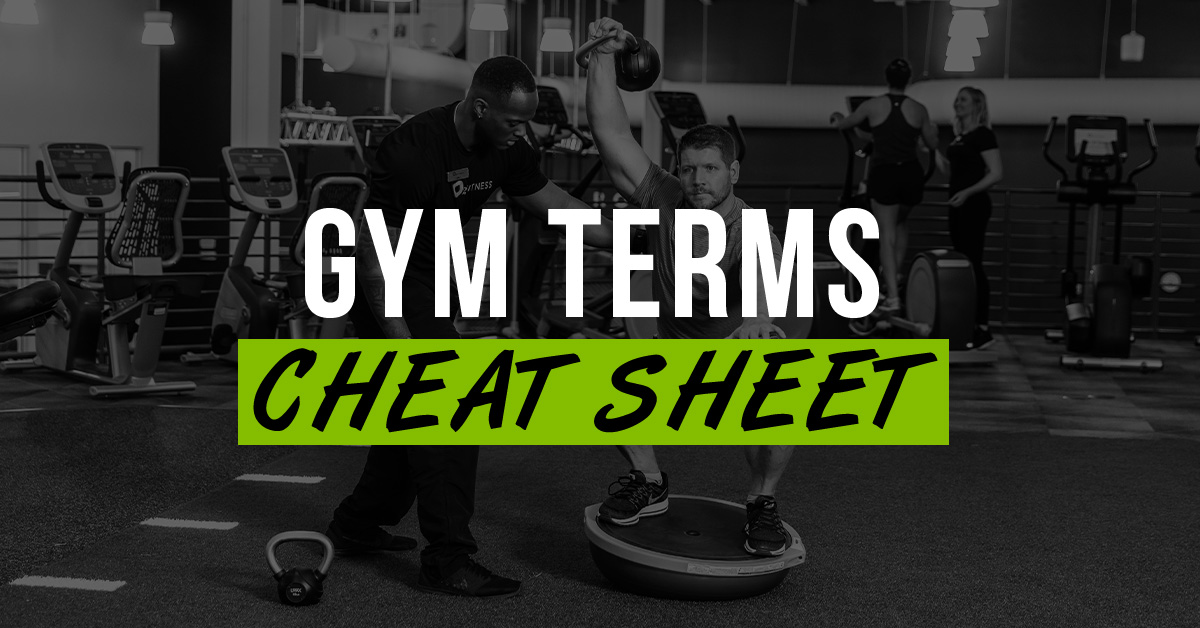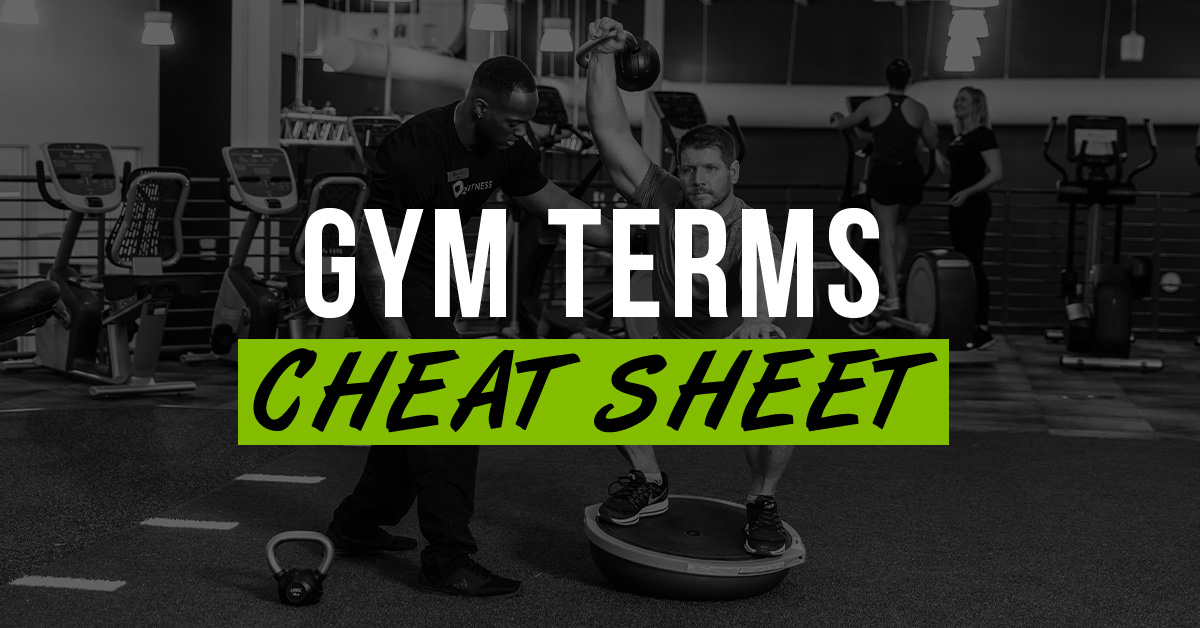The gym seems to have a language of its own. Learning a ton of new words and phrases on top of getting the hang of a new workout routine can feel pretty intimidating.
That's why we created this easy-to-understand cheat sheet for not-so-easy gym terms!
This blog will help you learn all the gym terms and slang you'll need to survive the gym (and it might just help you understand some future workouts and gym content from us too!)
Gym Terms You Need to Know
Active Recovery
"Active Recovery" is when you do some sort of low-intensity activity to restore your muscles after exercise. Active recovery exercises help by increasing the blood flow to your muscles and removing excess toxins that build up during high-intensity exercise.
AMRAP
"AMRAP" is an acronym for "As Many Rounds As Possible" or "As Many Reps As Possible." AMRAP workouts involve doing as many repetitions of an exercise as possible during a set amount of time without (or with limited) rest.
Compound Exercise
A "compound exercise" is an exercise that uses multiple muscle groups. It may also refer to two moves being strung together, like a bicep curl to a shoulder press. Compound exercises are great for increasing overall muscle and burning calories (because they typically require more effort to complete), as opposed to isolation exercises, which focus on a single muscle group.
Example: Squats, lunges, and deadlifts are all Compound Exercises.
Concentric
"Concentric" is a type of contraction that places tension on your muscles as it shortens. When your muscles shorten, they generate enough force and power to move an object which is the most popular type of muscle contraction.
Example: A bicep curl is an easy-to-recognize concentric movement because your muscle shortens when curling the weight upwards.
DOMS
"DOMS" is an acronym for "Delayed Onset Muscle Soreness." This muscle pain typically begins a day or two after you've worked out. It can be a sore, aching, or painful feeling. If this sore feeling stays longer than a few days, you may need to take more rest and focus further on recovery instead of trying to do another workout right away.
Eccentric
"Eccentric" is how we categorize exercises or movements involving muscle lengthening while it's contracted.
Example: Walking down stairs, running downhill, lowering weights, and the downward motion of squats, push-ups, or pull-ups are some examples of eccentric movements.
Functional Exercise
"Functional Exercises" are exercises that help you move and feel better in everyday life. They often mimic the ways you move outside of the gym and typically use large muscle groups throughout the body to complete them.
Example: Functional exercises are typically movements like walking, pushing, pulling, bending, squatting, lunging, and core.
H.I.I.T.
"HIIT" stands for High-Intensity Interval Training. This is a type of workout that alternates between short and explosive exercises followed by brief rest periods. Boot camp-style classes typically use HIIT workouts.
Isolateral
"Isolateral training is a technique for training one side of your body at a time. These exercises help you train both sides of your body equally and avoid developing a "stronger" and a "weaker" side.
Example: Lunges or single-arm overhead presses are two types of isolateral exercises.
Isometric
"Isometric" is an exercise where your muscles tighten (or contract) without any movement in surrounding joints. Isometric exercises are good for improving your endurance and strengthening muscles through stabilization!
Example: Glute Bridges and Planks are great examples of isometric exercises!
Load
The "load" is the intensity of a training session, the amount of stress placed on the body, or how much weight you are using during that exercise.
LISS or Steady-State Cardio
"LISS" is a common acronym for "Low-Intensity Steady-State Cardio." It is most commonly associated with cardio activities like running, cycling, walking, swimming, or other activities requiring low-intensity exercise for longer periods. This is a great way to train and improve your endurance!
Progressive Overload
"Progressive overload" is a method of strength training that gradually increases the demand placed on the musculoskeletal system. Progressive overload is done by gradually increasing the weight, frequency, or number of reps in your strength training routine to help your musculoskeletal system get stronger.
Example: You can easily do 10 reps of bicep curls with 10-pound dumbbells. So, to get stronger with progressive overload, you start doing 6 to 8 reps with 15-pound dumbbells until you can comfortably get to 10 reps again.
Progression
Unlike regression, "progression" is an approach that increases the demand for an exercise or movement. This can mean gradually increasing the weight, duration, or intensity of your weight training to see continued growth.
Regression
"Regression" is an approach to completing an exercise that lessens the demand of an exercise or a movement on the body. Sometimes this involves performing another exercise that targets similar muscle groups, and other times it can include using less weight than you usually would.
Reps
"Reps" is short for repetitions. So, a rep refers to the number of times to complete an exercise within a set.
Volume
"Volume" refers to the total amount of physical work you perform. This can be measured by the hours and minutes you train (for example, how long you train on the treadmill) or the number of sets and reps you do in a single workout.
Sets
A "set" is a cycle. It's the number of times you need to perform a group of reps to complete the exercise. Typically, you'll take a short break between sets to give your muscles time to rest and recover before starting again.
Example: 3 sets of 10 squats = 30 squats total.
Split
A workout "split" divides your training sessions by targeting different body regions or muscle groups. Workout splits are typically used in weight lifting, but they can also be used in bodyweight training!
Until Failure
In weight training, muscle "failure" refers to lifting weights so that a muscle can no longer contract concentrically. That means that the muscle is unable to perform another repetition.
You know you have trained to "failure" when you feel discomfort during the last few repetitions of an exercise or cannot complete the last few reps with proper form. (Typically, those funny faces you see yourself making in the mirror while lifting are a good sign you're working to failure!)
Warm-Up Sets
"Warm-Up sets" are sets done at a lower intensity than your working sets. Although they are the same movement, these sets don't count toward the number of working sets prescribed in your workout plan.
Working Sets
A "working set" is going to be the set where most of the work is done. During these sets, you'll be working until you are close to failure (but still able to keep proper form.) These sets are where your growth comes from!
Still have questions? That's OK!
There's a lot to learn when you're starting; luckily, we're happy to help.
Click here to book one of your two free personal training sessions to get your questions answered by one of our awesome, certified personal trainers!










.jpeg)
.jpg)
.jpg)